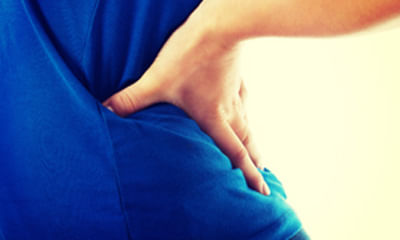Medicine For Breast Tenderness
Hi. I am 25 years old. My concern is my menstruation is delay for 5 days. I have frequent bearable cramps this day. I do ...
Ask Free Question
Menstrual cycles can vary in length and occasionally be irregular, so a delay of a few days may not necessarily indicate a problem. Stress, changes in weight or exercise patterns, hormonal imbalances, or certain medical conditions can all contribute to changes in the menstrual cycle. If you are sexually active and there is a possibility of pregnancy, it's understandable that you might be concerned about a late period. While a missed period can be an early sign of pregnancy, it's important to note that there are other factors that can cause a delay. Some early signs of pregnancy can include fatigue, breast tenderness, nausea, and frequent urination, among others. However, these symptoms can also be attributed to other causes, so it's essential to take a pregnancy test or consult a healthcare professional for a definitive answer. The presence of white or creamy discharge is a common occurrence throughout the menstrual cycle and can be influenced by hormonal changes. As for the cramps and feelings of having an lbm (loose bowel movement), these symptoms can also be experienced during menstruation or due to other factors, such as dietary changes or gastrointestinal issues.
My wife has taken ipill after 2nd day of ovulation cycle and having symptoms like nausea, breast tenderness and uneasine ...
Ask Free Question
That can not decide as such symptoms are also common because of high hormones in medicines like I pill. After taking the high hormonal emergency pill like I pill one gets withdrawal bleeding 5 to 10 days later, and then a new cycle starts. If this does not happen as well as the period is missed then do pregnancy test.
I had ipill more than a month ago and have bleed 3 times in one month the third time bleeding was for about 9 days durin ...
Ask Free Question
Good evening lybrate-userji. Ipill is an emergency contraceptive to prevent unwanted pregnancy, constituted with the drug levonorgestrel. It is adviced in female aged 24 -45 years and should be taken with in 72 hours but asap after the unprotected intercourse. Levonorgestrel can cause side effects in small group of female like, nausea, abdominal pain, headache, irregular bleeding, breast tenderness and disturbed menstrual cycles etc. Luckily in many women the symptoms are mild and lasts from days to months and without a need of specific medicine. I advice you to not to worry as all your complaints will subside in a short while. You can take symptomatic treatment for headaches and nausea and if they are moderate to severe then you may please consult a gynaecologist. Hope you have your answer and wish you fast recovery and please feel free to contact if still need further assistance.
My baby started developing temperature just yesterday and she’s also coughing. What can she use please? ...
Ask Free Question
Your baby seems to be suffering from upper respiratory tract infection and needs to take medications based on the weight of baby.
I got my last period on 19th april and next period on 5th may. This is the first time I got my period so early. Had inte ...
Ask Free Question
It could be at age 24. Pl be careful about proper food, mobility/ exercise- yog gym walk whatever and if need be modify your lifestyle. Now a days pcos is on a high in urban women and even girls younger than you have started showing early signs. Weight loss diet should not be emotional but scientific. Ayurvedic herbals are the medicine of choice if at all needed. Pl do not fall prey to 21 day tab (contraceptive pills) which is a fashion now to give synthetic hormones. It should be given in such cases only when no other things work. Once started, very few females are able to stop it in reasonable time. Pl go for ayurvedic herbals for regulating m.c. And aartav shuddhi (cleansing/ balancing physiological functions of female reproductive system) will be incidental. Believe it. So pl start with proper food, de-stress yourself, do regular exercises etc. For further guidance pl call on Lybrate phone or chat. You may also get our own ppt giving insights into your problem. Hirsutism, cysts etc are also present in many young ladies which lead to pcos.
Hlo Dr. I want to ask that mere last period 9 feb 2020 tk tha uske accordingly abi tk periods aa jane chahiye the dobara ...
Ask Free Question
Garbh nikalne ki davaiya sirf gynecologist ki dekhrekh me hi le sakte hai isliye gynecologist ko milo.
I was diagnosed with endometriosis last year and was on medication for 11 months. Now it's been two months since I stopp ...
Ask Free Question
1.You should maintain high grade of personal hygiene. 2.Do change your underclothes at least 2 times a day 3.Wear cotton under garments 4.Stay hydrated. Drink plenty of fluids. 5.Keep the area dry homeopathy is a very effective for this problem n has very encouraging results. And homeopathic medicines are safe and do not have any side effects at all.
I'm a civil engineer. Two months ago I have fell down on my left shoulder because of slippery road. Right from the next ...
Ask Free Question
Common rotator cuff injury symptoms include: •avoiding certain activities because they cause pain •difficulty achieving full range of shoulder motion •difficulty sleeping on the affected shoulder •pain or tenderness when reaching overhead •pain in the shoulder, especially at night •progressive weakness of the shoulder •trouble reaching behind the back if you’ve been experiencing any of these symptoms for longer than a week or lose function in your arm, see your doctor. Risk: rotator cuff injuries can be acute or degenerative. Acute injuries usually occur from one particular incident. These can be caused by lifting objects that are too heavy, falling, or having the shoulder forced into an awkward position. Young people are more likely to experience this type of rotator cuff injury. Degenerative injuries are due to long-term overuse. People most at risk for these injuries include: •athletes, particularly tennis players, baseball players, rowers, and wrestlers •people with jobs that require repetitive lifting, such as painters and carpenters •people above 40 years of age treated: treatments range from resting the affected arm to surgery. Tendinitis can progress to a rotator cuff tear, and that injury can get worse with time. Seeking treatment as quickly as possible helps keep the injury from progressing. Nonsurgical treatments improve symptoms in about 50 percent of people with a rotator cuff injury. These kinds of treatments include: •applying hot or cold packs to the affected shoulder to reduce swelling •exercises to restore strength and range of motion •injecting the affected area with cortisone, a steroid that helps to reduce inflammation •resting the affected arm and wearing a sling to isolate arm motions 1.pendulum stretch do this exercise first. Relax your shoulders. Stand and lean over slightly, allowing the affected arm to hang down. Swing the arm in a small circle — about a foot in diameter. Perform 10 revolutions in each direction, once a day. As your symptoms improve, increase the diameter of your swing, but never force it. When you're ready for more, increase the stretch by holding a light weight (three to five pounds) in the swinging arm. 2. Towel stretch hold one end of a three-foot-long towel behind your back and grab the opposite end with your other hand. Hold the towel in a horizontal position. Use your good arm to pull the affected arm upward to stretch it. You can also do an advanced version of this exercise with the towel draped over your good shoulder. Hold the bottom of the towel with the affected arm and pull it toward the lower back with the unaffected arm. Do this 10 to 20 times a day. 3. Finger walk face a wall three-quarters of an arm's length away. Reach out and touch the wall at waist level with the fingertips of the affected arm. With your elbow slightly bent, slowly walk your fingers up the wall, spider-like, until you've raised your arm as far as you comfortably can. Your fingers should be doing the work, not your shoulder muscles. Slowly lower the arm (with the help of the good arm, if necessary) and repeat. Perform this exercise 10 to 20 times a day. 4. Cross-body reach sit or stand. Use your good arm to lift your affected arm at the elbow, and bring it up and across your body, exerting gentle pressure to stretch the shoulder. Hold the stretch for 15 to 20 seconds. Do this 10 to 20 times per day. 5. Armpit stretch using your good arm, lift the affected arm onto a shelf about breast-high. Gently bend your knees, opening up the armpit. Deepen your knee bend slightly, gently stretching the armpit, and then straighten. With each knee bend, stretch a little further, but don't force it. Do this 10 to 20 times each day. Starting to strengthen as your range of motion improves, add rotator cuff–strengthening exercises. Be sure to warm up your shoulder and do your stretching exercises before you perform strengthening exercises. 6. Outward rotation hold a rubber exercise band between your hands with your elbows at a 90-degree angle close to your sides. Rotate the lower part of the affected arm outward two or three inches and hold for five seconds. Repeat 10 to 15 times, once a day. 7. Inward rotation stand next to a closed door, and hook one end of a rubber exercise band around the doorknob. Hold the other end with the hand of the affected arm, holding your elbow at a 90-degree angle. Pull the band toward your body two or three inches and hold for five seconds. Repeat 10 to 15 times, once a day. Shoulder exercises and stretches regular exercises and stretches can keep your shoulder strong and flexible. A few things to remember before swinging in to exercises: •stop any exercise if you have more shoulder pain. It may be too soon for you to try. •watch your form. Exercising incorrectly can also cause or worsen shoulder problems. •warm up, even before deep stretching. Light shoulder rolls, gentle movements, or even a warm shower are all ways to warm up your muscles before exercise and stretching. Pendulum stretch for range of motion stand and bend at the waist. •let your arm on the injured side hang straight down. •keep your neck relaxed. •move your arm in a circle up to 20 times. •do once or more times in a day. Overhead shoulder stretch sit or stand to do this shoulder stretch. •intertwine your fingers in front of you. •bend your elbows and raise your arms above your head. You can also place your hands on your head or behind it. •gently squeeze your shoulder blades together to move your elbows back. •continue for up to 20 repetitions. Repeat 5 to 10 times a day.1.pendulum stretch do this exercise first. Relax your shoulders. Stand and lean over slightly, allowing the affected arm to hang down. Swing the arm in a small circle — about a foot in diameter. Perform 10 revolutions in each direction, once a day. As your symptoms improve, increase the diameter of your swing, but never force it. When you're ready for more, increase the stretch by holding a light weight (three to five pounds) in the swinging arm. 2. Towel stretch hold one end of a three-foot-long towel behind your back and grab the opposite end with your other hand. Hold the towel in a horizontal position. Use your good arm to pull the affected arm upward to stretch it. You can also do an advanced version of this exercise with the towel draped over your good shoulder. Hold the bottom of the towel with the affected arm and pull it toward the lower back with the unaffected arm. Do this 10 to 20 times a day. 3. Finger walk face a wall three-quarters of an arm's length away. Reach out and touch the wall at waist level with the fingertips of the affected arm. With your elbow slightly bent, slowly walk your fingers up the wall, spider-like, until you've raised your arm as far as you comfortably can. Your fingers should be doing the work, not your shoulder muscles. Slowly lower the arm (with the help of the good arm, if necessary) and repeat. Perform this exercise 10 to 20 times a day. 4. Cross-body reach sit or stand. Use your good arm to lift your affected arm at the elbow, and bring it up and across your body, exerting gentle pressure to stretch the shoulder. Hold the stretch for 15 to 20 seconds. Do this 10 to 20 times per day. 5. Armpit stretch using your good arm, lift the affected arm onto a shelf about breast-high. Gently bend your knees, opening up the armpit. Deepen your knee bend slightly, gently stretching the armpit, and then straighten. With each knee bend, stretch a little further, but don't force it. Do this 10 to 20 times each day. Starting to strengthen as your range of motion improves, add rotator cuff–strengthening exercises. Be sure to warm up your shoulder and do your stretching exercises before you perform strengthening exercises. 6. Outward rotation hold a rubber exercise band between your hands with your elbows at a 90-degree angle close to your sides. Rotate the lower part of the affected arm outward two or three inches and hold for five seconds. Repeat 10 to 15 times, once a day. 7. Inward rotation stand next to a closed door, and hook one end of a rubber exercise band around the doorknob. Hold the other end with the hand of the affected arm, holding your elbow at a 90-degree angle. Pull the band toward your body two or three inches and hold for five seconds. Repeat 10 to 15 times, once a day. Shoulder exercises and stretches regular exercises and stretches can keep your shoulder strong and flexible. A few things to remember before swinging in to exercises: •stop any exercise if you have more shoulder pain. It may be too soon for you to try. •watch your form. Exercising incorrectly can also cause or worsen shoulder problems. •warm up, even before deep stretching. Light shoulder rolls, gentle movements, or even a warm shower are all ways to warm up your muscles before exercise and stretching. Pendulum stretch for range of motion stand and bend at the waist. •let your arm on the injured side hang straight down. •keep your neck relaxed. •move your arm in a circle up to 20 times. •do once or more times in a day. Overhead shoulder stretch sit or stand to do this shoulder stretch. •intertwine your fingers in front of you. •bend your elbows and raise your arms above your head. You can also place your hands on your head or behind it. •gently squeeze your shoulder blades together to move your elbows back. •continue for up to 20 repetitions. Repeat 5 to 10 times a day.Prevented: athletes and people with occupations that require using the shoulder should take frequent rest breaks. This can reduce the load on the shoulder. Exercises to strengthen the shoulder and encourage range of motion also can help. Ask your physical therapist for stretches and strengthening exercise to improve the function of your rotator cuff. In the case of shoulder pain, icing the affected area can help reduce swelling. Apply ice in a cloth-covered pack for no more than 10 minutes at a time. These activities can also help prevent re-injury.
I am 21 years old when I was 17 years old I used to do masturbation in excess amount then I feel weak sexually and my ch ...
Ask Free Question
Hello- gynecomastia is a condition that affects men, in which the breast tissues become swelled and take on a fuller look that can be embarrassing for many. It occurs as a result of irregular levels of hormones in the body during puberty. Gynecomastia can affect one or both breasts and may also have uneven development. The most common signs and symptoms include swollen breast glandular tissue and breast tenderness. The most common cause of gynecomastia is changes in the levels of hormones? Androgens and estrogens. This can happen due to a variety of reasons including puberty, age, hypogonadism, low testosterone (male hormone), hyperthyroidism, chemotherapy, radiation treatment, chronic liver disease, exposure to pollutants, kidney failure, use of marijuana, excess alcohol consumption, malnutrition, and side effects of certain medications. Being overweight can also add to the problem. Many men find it really tough to cope with the condition and opt for medication or even surgery. Ayurvedic medicine offers complete cure of gynecomastia. It is worth noting that in recent years, medicine has made great progress in this field. So, if you looking for a permanent solution for your male breasts, yes it is possible with ayurveda. Surgery can be avoided.
Am 20 yrs, I have 3 problems, 1 I ejaculate in less than a minute during sex it has been bothering me for a good 3 years ...
Ask Free Question
I guarantee you best and permanent results for all your 3 problems. For better guidance and natural, safe and permanent treatment of your problems, call or enquire me through Lybrate.








